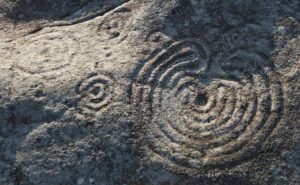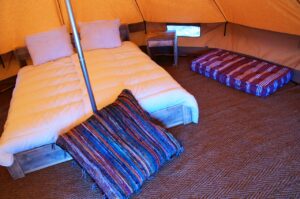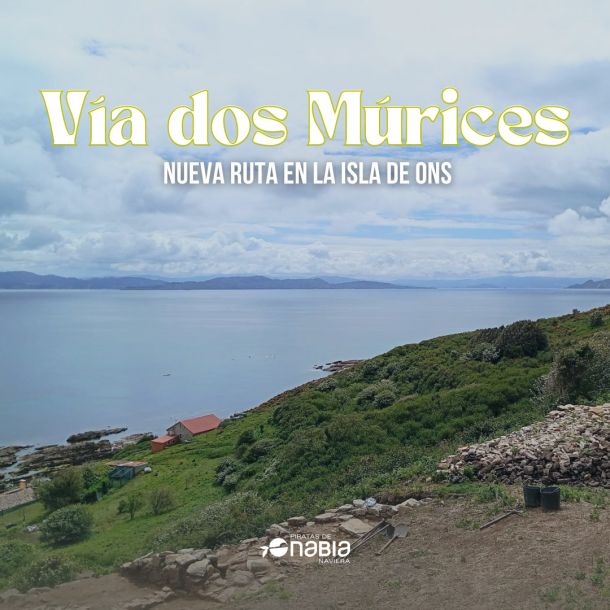Come and visit the island of Ons, a great little island.
Visiting the island of Ons is one of the biggest attractions for every traveler who comes to the National Park of the Atlantic Islands (Galicia). Belonging to the municipality of Bueu, in the province of Pontevedra, the island of Ons offers a natural treasure and a whole range of tourist and gastronomic offerings that will make the visit one of your best trips.
From Piratas de Nabia we invite you to get on board and set sail to this little jewel of our Rías Baixas. We are all ready at the port, shall we leave?
- Come and visit the island of Ons, a great little island.
WHERE IS ONS ISLAND AND HOW CAN I VISIT IT?
Ons Island is the largest island of the Ons Archipelago. This archipelago is located at the entrance of the Ría de Pontevedra and is 4 km away from the mainland. It consists of the island of Ons, the small island of Onza and a series of small islets that extend along the coast of both, including O Centolo, at the northern end of the island, and the islet of A Freitosa to the south. The island measures from north to south about 5.9 km, and 1.3 km wide. With a profile in profile, its maximum height is registered in Alto do Cucorno. At this point we will find the famous lighthouse of the island of Ons. Above sea level, the lighthouse is 128 m above sea level and its light is visible for 24 nautical miles.
The total extension of the archipelago and its waters is 2,641 hectares, adding its 2,171 maritime hectares and 470 terrestrial hectares (4,458 km2) and geographically located at 42º 22′ north latitude and 8º 56′ west longitude. It is located on the map to the north of the Cíes Islands, both formations having formed part of a mountain range in the past, submerged in our era in front of the Rías Baixas.
Ons Island currently has a permanent population of 78 inhabitants according to the 2010 census. However, to nearly half a thousand in the summer monthsThanks to all the tourists who wish to visit the island and residents of other municipalities of the Galician coast who choose Ons as a holiday destination, mainly at Easter, weekends in May and the months of July and August.
You can only visit the island of Ons by private boat, for which it is necessary to request an anchoring permit, or aboard a ship of a shipping company. Naviera Nabia provides this service in high season, with different schedules and routes departing from Bueu and Portonovo. You can obtain more information about these services, schedules and ticket fares by calling +34 986 320 048.
A LITTLE BIT OF HISTORY

Visiting the island of Ons is a journey in which to contemplate thousands of years of history. Pliny the Elder already described the island in his works on the Iberian Peninsula. He called it insula Aunios, a name with an Indo-European root that clearly refers to water and its flow. However, there is information about settlements in Ons that date back much further, Paleolithic remains have been found, as well as remains from the metal age. The remains of two castros that developed on the islandwhose splendor was lived at the end of the Bronze Age. A castro is a fortified settlement characteristic of the Celtic people, generally pre-Roman, which is typically located in the Rías Baixas and also throughout the northwest of the peninsula.
Although we do not have much data, it is known that in the Middle Ages it was a place of congregation of hermit monks, and over the years, the ownership of the archipelago passed through various hands. Thus, until the tenth century it was owned by the Kings of Galicia, then passed to the Archbishopric of Santiago de Compostela, which in the sixteenth century donated the land to the noble family Montenegro.
Like many Atlantic islands of Galicia, in its past it was a refuge of pirates, always inhabited also by all kinds of sailors and settlers during the Modern Age. In the 19th century, the islands became part of the properties of the Marquisate of Valladares, which established a small salting industry, and changed hands again at the beginning of the 20th century. In the middle of the last century, for social and labor reasons, the island experienced a population boom, reaching 530 people in 1955.
In 1981, Ons was ceded to the Xunta de Galicia and thus became part of the national public domain. It will also be recognized as a National Park and, since 2001, the archipelago has been part of the Parque Nacional Marítimo-Terrestre das Illas Atlánticas de Galicia.The islands of Cíes, Sálvora Island and Cortegada Island.
ONS ISLAND OR CÍES ISLANDS?
There are many travelers who hesitate about visiting Ons Island or the Cíes Islands. Trying to decide between two trips to different places is not easy! Without leaving Galicia, is it preferable to visit San Simón Island or San Vicente del Mar? Is it possible to eat higher quality seafood in the Ría de Vigo or in the Ría de Arousa? Is Melide Beach more beautiful than Viñó or Nerga Beaches? Rías altas or Rías Baixas? Vacation in July or August?
Faced with these dilemmas, We can only answer that, if it’s all about travel and enjoyment, why not visit both? It is true that, in recent years, the island of Ons has been somewhat overshadowed by the Cíes Islands and that, although the whole group is part of the Parque Nacional das Illas Atlánticas, the latter have enjoyed greater popularity and publicity. Perhaps it is due to the choice of the British newspaper The Guardian, some years ago, of Rhodes Beach as the best beach in the world, with its fine white sands. However, Ons is gradually removing the complexes, making it clear that on this island there are as many natural wonders to admire and beaches to enjoy as on its sister islands.
Visiting Ons Island or Cíes Islands? Ons Island and Cíes Islands!
WHAT TO VISIT ON THE ISLAND OF ONS?

Whether you plan to sleep on the island of Ons and spend a few days there, or you prefer a shorter visit. and return, you can enjoy all that this site has to offer through the guided excursions offered by the Park services and hiking trails self-guided trails are available on the trails. As of today, September 18, 2018, there are already up to four self-guided routes covering almost the entire length of the island:
- NORTHERN ROUTE. As its name indicates, it runs along the entire northern part and then crosses the island through its narrowest part. It is the longest of the four routes, it covers just over eight kilometers and runs along the cliffs of the Atlantic coast, where you can see the breeding of various species of birds, sheltered from the peculiar climate of the Rías Baixas. Also seen on this route is Melide Beach, nudist beach of Ons, and its impressive dunes. This route is usually completed in about three hours and its difficulty is medium – difficult.
- SOUTHERN ROUTE. Two and a half hours longwith a length of 6.2 kilometers and medium difficulty, the southern route includes some of the must-see places for visitors, such as the Fedorentos viewpointwhich offers an impressive panoramic view from the island to the National Park in all its extension, or the Buraco do Inferno (literally, Hell Hole), an astonishing chasm of more than 40 meters deep where, according to legend, all the laments of the souls in sin can be heard on windy days. To appease ours, during the tour we will walk along the beaches of the southern part of the island, such as Area dos Cans or Pereiró Beach.
- ROUTE DO CASTELO. Perhaps the most popular of all the routes on the island, a light walk of only 1.1 km. and medium difficulty – easy. It starts at the emblematic Praia das Dornas, where you can see some old sailing fishing boats (the typical dornas), and continues along the coastline and a small willow forest, heading north, to the viewpoint do Castelo, with excellent views of the entire Ría de Pontevedra and its beaches. Afterwards, the route descends inland towards O Curro, the main population center of the island of Ons. All this in a gentle hiking excursion of about 40 minutes where there is only about 33 meters of unevenness.
- LIGHTHOUSE ROUTE. It starts at the information booth on the island of Ons, in O Curro, and ascends towards the neighborhood of Cucorno. Its destination is the lighthouse at 128 m. The lighthouse is still operated by a lighthouse keeper, and then descends along the cliffs until it reaches the Caniveliñas inlet. At its lowest point, take a path that crosses the width of the island to return to the starting information point. A total of 4 kilometers are covered in an hour and a half, being the easiest of the four routes.

In addition to hiking and trails on land, it should be remembered that this is a Maritime Terrestrial Natural Park. Whether visiting Ons Island or the Cíes Islands, the best way to get to know the mysteries hidden in the sea is to dare to dive into its waters, practicing snorkeling, free diving or scuba diving. The Pontevedra estuary is home to different varieties of algae, fish and rock formations that serve as an environment and shelter for all types of marine fauna and flora. If diving is not your thing, you can always enjoy a catamaran trip in which you can see through its deck and discover all the secrets of nature under the sea of the estuaries.
The Camino de Santiago can also be traveled by boat on its maritime route. Towards Iria Flavia, the Camino passes near the islands of Ons and Sálvora. It is the only route that runs mainly by boat, to finally join the Portuguese route.
EATING ON THE ISLAND OF ONS
Visiting the island of Ons is synonymous of a great gastronomic experience. Seafood, fish, pies, wines... all the natural flavor of Galicia is enjoyed twice as much listening to the sea, watching the sky, contemplating Bueu, Onza Island or the Cies Islands in the background.
Since 1945, Casa Acuña has been one of the most highly regarded restaurants by all visitors to the island. Palmira Acuña, who runs this restaurant with capacity for 200 diners, boasts of preparing the best octopus in Galicia, and no wonder, since her cuisine has been recognized with several awards. All the fish and seafood prepared are fresh, from the Rías Baixas, and are accompanied by the best wines of the area. For the customer it is like eating at home, because the concern of the staff for customer service and quality make Casa Acuña one of the best restaurants in Galicia. It is open every day from Easter to October.
Another good option to eat on the island of Ons, a few meters from Casa Acuña, is the Bar O Pirata. Specialized in churrasco and seafood, it offers menu of the day and is open every day during the high season, from June 22 to September 15. It is a meeting place on the island, perhaps thanks to the fact that it is one of the restaurants that offers the best views of the estuaries from its terrace, in a privileged natural environment.
SLEEPING ON THE ISLAND OF ONS

Sleeping in Ons Island is the best option if you want to enjoy your trip with more tranquility. We found two interesting offers to stay overnight on the island.
The aforementioned Casa Acuña has a guesthouse with 20 double rooms with individual bathrooms. The rooms are fully equipped and have a cozy and modern look. Also noteworthy are the spectacular views from the windows of the rooms.
If you prefer to visit the island of Ons even more in contact with nature, Camping Isla de Ons guarantees you a unique experience in your trip. This is the first self-sustainable campsite in Galicia, totally respectful of its environment, and with modern facilities where you can enjoy this natural paradise as never before.
It has a large camping area delimited by plots, where you can place your own tent or rent one of the tents that the campsite makes available to the customer. And this is where we find one of the most pleasant surprises offered by Camping Isla de Ons: the glamping.

Glamping is becoming more and more fashionable all over the world and is a very attractive travel option for thousands of people. Camping Isla de Ons has the widest range of glamping facilities in Galicia. This is the perfect combination of glamour and camping, because we all like to enjoy nature while camping, but we also want to make our rest something totally pleasant, which is not always possible in a traditional tent. Camping Isla de Ons offers a modern canvas tent on a wooden base with all the glamping equipment: tables, mattresses, pillows, porch… It is enough to try it once to realize that gampling is the comfort of a house brought to the campsite. One of the best alternatives for all your trips.
In addition, for both gampling and traditional camping area users, Camping Isla de Ons has a playground for children, cafeteria and laundry facilities, grocery store and other services such as first aid, clean point, information point, shuttle service and security service. The campground is handicapped accessible. Throughout the high season there are various activities and shows for children and adults and there is easy access to beaches in the area.

Due to the high demand it is not easy to find a free place, so we recommend making reservations whatever option you choose to spend the night on your visit to the island of Ons. The campsite can be booked through its website.
Finally, remember that Ons Island is part of a Natural Park, and that, according to its policy, pets are not allowed.
VISIT THE ISLAND OF ONS , AND VISIT IT AGAIN!

We hope you enjoyed this short trip around the island of Ons. We are willing to come back again and again and we are sure you will too. Have you been fortunate enough to visit Ons Island? Have you bathed in its beaches?
What did you think of your trip? Would you like more information? If you want to share your impressions with us, or if you are still hungry for more, we encourage you to follow us on our Facebook and Twitter channels. Leave a comment, give us your opinion, take a look at the most spectacular photos of the area or find out about the next adventure to be published. Or, if you prefer, follow us on board and choose other destinations on our website.


